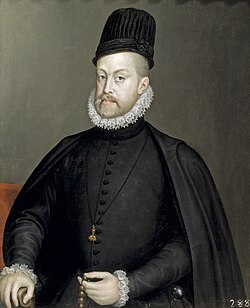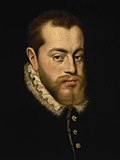Philip II of Spain
Philip II of Spain (21 May 1527 – 13 September 1598) was, starting in 1556, king of Spain, and Burgundy, Netherlands, Naples, Sicily, and Spanish America. He was born in Valladolid and was the only son of Holy Roman Emperor Charles V and his wife to live until he was an adult. He was strongly Catholic.
| Phillip II of Spain | |
|---|---|
| King of Spain | |
 | |
| King of Spain | |
| 16 January 1556 – 13 September 1598 | |
| 16 January 1556 | |
| Predecessor | Charles V, Holy Roman Emperor |
| Successor | Phillip III of Spain |
| Co-Monarch | Mary Tudor of Greenwich (1556 – 1558) |
| Born | Felipe of Spain 21 May 1527 Palacio de Pimentel, Valladolid, Kingdom of Spain |
| Died | September 13, 1598 (aged 71) El Escorial, San Lorenzo de El Escorial, Kingdom of Spain |
| Burial | 13 September 1598 El Escorial |
| Spouse | |
| Issue | |
| House | House of Hapsburg |
| Father | Charles V, Holy Roman Emperor |
| Mother | Isabella of Portugal |
| Religion | Roman Catholicism |
| Signature | |
His rule was filled with troubles since his war against the Dutch Republic was expensive and unsuccessful, and his Spanish Armada was defeated and destroyed, which caused him to be harsh to his subjects.
Childhood
For the first seven years of his life, Philip moved between different castles with his mother. In 1534 he moved into a private house in Salamanca to start his schooling. His mother died in 1539 and he took her body to Granada, where his great-grandparents Ferdinand II of Aragon and Isabella were buried. He left Spain in 1547 and moved to the Netherlands, where his father's family was from. His father wanted him to become more European but the people there thought he was too cold and serious.
Marriages and children
- He married his cousin, Maria of Portugal, in (1543), They were both 16 years old. She gave him a son, Don Carlos of Spain (1545-1568) but died a few days later.
- Philip wanted to marry an English queen, Queen Elizabeth I of England, who was Protestant. However, she refused to marry him.
- Instead, he married her Catholic half-sister, Queen Mary I of England in 1554. This made him King Consort while she lived. Her people did not like the marriage, and Philip saw it only as a political move. On January 16, 1556, Philip became King of Spain when his father gave up the throne but Philip chose to stay out of the country until his father died, two years later. Mary died in 1558 without children.
- Philip believed his son, Don Carlos had planned his death, so he put Don Carlos in jail. The prince died soon after, so Philip's enemies said that he had ordered someone to kill him. Some evidence shows this, but it was probably too much eating and drinking that killed Don Carlos.
Titles/styles/honors
Phillip II obtained most of his titles from his parents. He also obtained some other titles later, like King of Portugal.
In Castile he was: King of Castile, Leon, Grenada, Toledo, Seville, Cordoba, Murcia, Jaen, Algarves, Gibraltar, Algeciras, Canary Islands, of the Indias, the Islands and Mainland of the Ocean Sea, and Lord of Molina.
In Aragon he was: King of Aragon, Majorca, Menorca, Sardinia and Corsica, Naples, Sicily, Valencia, Navarre, Jerusalem, Margrave of Oristano, Count of Goceano, Count of Barcelona, Count of Roussillon, Count of Cerdanya, Duke of Athens, Duke of Neopatria.
In Portugal he was: King of Portugal, either side of the sea in Africa, Lord of Guinea and of Conquest, Navigation, and Commerce of Ethiopia, Arabia, Persia, and India, etc.
In England he was: King of England and France (titular) and Ireland.
Hapsburg Titles: Duke of Milan, Imperial vicar of Siena, Archduke of Austria, Princely Count of Habsburg and of Tyrol, Prince of Swabia.
In Burgundy: Lord of the Netherlands, Duke of Lothier, of Brabant, of Limburg, of Luxemburg, of Guelders. Count of Flanders, of Artois, of Hainaut, of Holland, of Zeeland, of Namur, of Zutphen. Margrave of the Holy Roman Empire, Lord of Frisia, Salins, Mechelen, the cities, towns and lands of Utrecht, Overyssel, GroningenCount Palatine of Burgundy from 10 June 1556; Count of Charolais from 21 September 1558
- Duke of Burgundy
- Dominator in Asia, Africa
Honours
- Knight of the Golden Fleece: 1531 – 13 September 1598
- Grand Master of the Order of the Golden Fleece:[75] 23 October 1555 – 13 September 1598
- Grand Master of the Order of Calatrava: 16 January 1556 – 13 September 1598
- Grand Master of the Order of Alcantara: 16 January 1556 – 13 September 1598
- Grand Master of the Order of Santiago: 16 January 1556 – 13 September 1598
- Grand Master of the Order of Montesa: 8 December 1587 – 13 September 1598
Issue
| Name | Born | Died | Mother |
|---|---|---|---|
| Carlos, Prince of Asturias | 8 July 1545 | 24 July 1568 | Maria Manuela, Princess of Portugal |
| Stillborn child | April 1555 | April 1555 | Mary Tudor of Greenwich |
| Stillborn twins | 1556 | 1556 | Mary Tudor of Greenwich |
| Miscarried twin daughters | August 1564 | August 1564 | Elisabeth of Valois |
| Isabella Clara Eugenia | 12 August 1566 | 1 December 1633 | Elisabeth of Valois |
| Catalina Micaela of Spain | 10 October 1567 | 6 November 1597 | Elisabeth of Valois |
| Joan | 3 October 1568 | 3 October 1568 | Elisabeth of Valois |
| Ferdinand, Prince of Asturias | 4 December 1571 | 18 October 1578 | Anna of Austria, Queen of Spain |
| Charles Laurence | 12 August 1573 | 30 June 1575 | Anna of Austria, Queen of Spain |
| Diego, Prince of Asturias | 15 August 1575 | 21 November 1582 | Anna of Austria, Queen of Spain |
| Philip III of Spain | 14 April 1578 | 31 March 1621 | Anna of Austria, Queen of Spain |
| Maria | 14 February 1580 | 5 August 1583 | Anna of Austria, Queen of Spain |
Philip II Of Spain Media
Philip, in the prime of his life, by Anthonis Mor
Philip II wearing the order of the garter by Jooris van der Straeten, c. 1554
A marble bust of Philip II of Spain by Pompeo Leoni, Metropolitan Museum of Art
Philip II berating William of Orange, by Cornelis Kruseman
References
- Der Traum Philipps des Zweiten (English: The Dream of Philip II). 'Edgar Maas'






